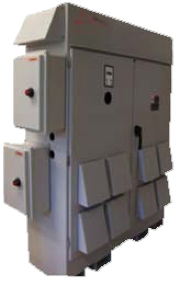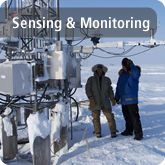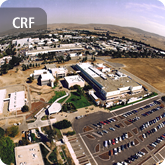Solar engineering, especially photovoltaic (PV) technologies, has been growing by leaps and bounds. This is fueled by intense private-sector interest in renewable energy (RE) power generation (on both the residential and commercial scale) and state mandates that utilities generate defined percentages of the electricity they provide from RE sources. Thirty five states have adopted these renewable portfolio standards (RPSs) with “due dates” ranging from 2015 to 2035.
The RE power-generation sector is growing so fast that existing technologies will have to be ready to support an interactive power grid at larger scales than ever before. With distributed power generation, the disparate elements of the power generation, transmission, and distribution network will have to move from a passive configuration—where power is “pushed” from a central generating facility through transmission lines and substations to be distributed to the end user—to an active model—where power is generated in many places and flows in many directions across the network, requiring intelligent agents at all nodes in the network to communicate needs and requirements as well as available resources and price information.
This new grid is challenging because the grid architecture is constantly evolving; the functionality of these new grid components necessary to support this grid are not yet well defined. What we do know is that all components will be required to carry out communication functions in addition to their normal generation, transmission, and/or distribution functions.
SEGIS is a Sandia-initiated technology-development concept that the DOE embraced. Its goal is to provide federal support to parties interested in thinking about what components will be needed to bring this smart grid into reality and move industry toward that vision—to build the platforms that will be ready to implement these new power generation and distribution concepts when the market is ready for them.the first round of technology development has been successfully completed. Sandia worked with four industry partners to develop the components described below.
Products to Enable the Intelligent Controls of the Future Grid

Micro-inverter and PV module
Sandia worked with Petra Solar (South Plainfield, NJ) and utility partners PSE&G and PEPCO to develop a micro-inverter. This project included design and development of
- a new micro-inverter design for 240 Vac and attachment to PV modules;
- system control integration to enable “Power on a Pole” concept for utility distribution systems (100,000 already on PSE&G poles);
- SEGIS “smart grid” interconnect functionalities/controls;
- communications methods (mesh network) to monitor the performance of micro-inverters, while at the same time reporting utility grid voltages and trends; and
- systems that go well beyond a just a micro-inverter.
Utility customers now are liking smart solar (SEGIS) functionalities.

New 100 kVA 4-port Demand-Response Inverter (R&D100-2011 Winner)
Sandia worked with Princeton Power (Princeton, NJ) and utility partner PSE&G to develop a demand-response inverter. This project included design and development of
- an advanced demand-response inverter with multiple ports for dedicated loads, energy management, PV, or other source input and utility interconnection;
- a new nanocrystal transformer core design that reduces size and weight by 90%;
- three times better reliability for capacitors by using self-healing film capacitors in a high frequency link for galvanic isolation;
- a smart controller and human-machine interface for friendly user/utility monitoring and control;
- enhanced communications ports that enable two-way communications for utility/owner controls and monitoring; and
- a new demand-response inverter product for better performance, manufacturability, and reliability.

New advanced inverter/controller, interface, and MPPT for SEGIS smart inverters.
Sandia worked with PV Powered (Bend, OR) and utility partner Portland General Electric to develop an advanced inverter/controller. This project included design and development of
- SEGIS integrated into inverter product line with functionalities that can be applied to PV applications large and small. (10 kW–10 MW size hardware);
- new maximum power point tracking (MPPT) algorithm for all PV technologies (thin film, crystalline, and concentrating) and proposed a new test protocol for a standard to certify MPPT performance;
- an integrated “synchrophasor” island detection technology to enable high penetration and advanced utility-interactive controls for PV on the distribution network; and
- adaptors and advanced database that enable stakeholders to assess functionality and performance of systems.

Shared inverter configuration
Sandia worked with the Florida Solar Energy Center (FSEC, Cocoa, FL) and SatCon Technology Corporation (Boston, MA) and utility partner Lakeland Electric to develop a shared inverter. This project included design and development of
- a new grid-smart shared inverter to bring aggregated PV power together with new SEGIS functionalities;
- a smart string combiner that extracts maximum power from a PV array for each string and aggregates the output to a common dc bus;
- utility “permissive link” signals that enable two-way communications to optimize power delivery, utility needs, and economics; and
- an integrated site controller to enable utility permissive link methods to manage power delivery, safety, and features such as islanding control and utility control of reactive power for voltage regulation and/or flicker.
Reports
- Advanced Energy Industries, Inc. SEGIS Developments, Authors: Ward Bower, Sigifredo Gonzalez, Abbas Akhil, Scott Kuszmaul, Lisa Sena-Henderson, Carolyn David, Michael A. Mills-Price, Mesa P. Scharf (SAND Report, 2 MB)
- Development of Economically Viable, Highly Integrated, Highly Modular SEGIS Architecture, Authors: Ward Bower, Sigifredo Gonzalez, Abbas Akhil, Scott Kuszmaul, Lisa Sena-Henderson, Carolyn David, Hussam Alatrash, Ruba Amarin, Evlyn Mark, Mohammad Kuran, Khalid Rustom, Rick Stuby, Ghaith Haddad, Ronald Hamaoui, and Johan Enslin (SAND Report, 10.1 MB)
- Solar Energy Grid Integration Systems: Final Report of the Florida Solar Energy Center Team, Authors: Ward Bower, Sigifredo Gonzalez, Abbas Akhil, Scott Kuszmaul, Lisa Sena-Henderson, Carolyn David, Robert Reedy, Kristopher Davis, David Click, Houtan Moaveni, Leo Casey, Mark Prestero, Jim Perkinson, Stanley Katz, Michael Ropp, Alan Schaffer (SAND Report, 4.9 MB)
- Solar Energy Grid Integration Systems: Final Report of the Princeton Power Systems Development of the 100kW Demand Response Inverter, Authors: Ward Bower, Sigifredo Gonzalez, Abbas Akhil, Lisa Sena-Henderson, Carolyn David (SAND Report, 5.7 MB)
Presentations
- SEGIS and the SMART GRID, Authors: Ward Bower, Christ Cameron, Sig Gonzalez, Abbas Akhil, Scott Kuszmaul, Lisa Sena-Henderson, Carolyn King David (Presentation, 2.9 MB)
 ECIS Highlights
ECIS Highlights













 RSS
RSS Google+
Google+ Twitter
Twitter Facebook
Facebook LinkedIn
LinkedIn YouTube
YouTube Flickr
Flickr


